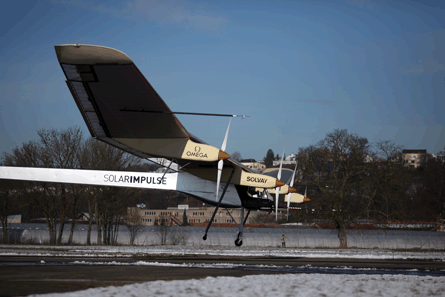The history of electric-powered flight goes back to the 19th century, but development has come in bursts. Today, a focus on solar-powered flight is driving several innovative projects.
Switzerland-based Solar Impulse is ready to make the first flight of its HB-SIA prototype, to kick off a development programme the company hopes will culminate in 2013 circumnavigation mission to highlight the potential of renewable energy.
Solar Impulse plans to fly HB-SIA at 25kt (46km/h) for 2h at up to 4,000ft (1,220m) at the Swiss military airfield at Payerne, west of Berne. The team first got off the ground in December 2009 with a runway hop near Zurich.
 |
|---|
© Solar ImpulseSolar Impulse HB-SIA made a 350m hop on 3 December 2009 |
A successor to HB-SIA will make the circumnavigation attempt. Design work will start in June, with a first flight in 2011. The team's goal is to fly that aircraft around the world in stages, each five days and five nights long, says chief executive André Borschberg. The plan is for wing-mounted solar cells to charge the aircraft's lithium polymer batteries before take-off, with sunlight powering the daytime segments and charging the batteries for power during the night.
The aircraft will have 200m2 (2,150ft2) of solar cells over its 64m wing span and batteries with a capacity to consume 84kWh of energy. With four tractor propellers using specially developed 8.5kW brushless motors and in-house designed energy management systems, the 1,600kg (3,520lb) aircraft will draw 34kW to take-off, up to 20kW to climb during the day and as little as 7kW to fly during the night. During the day the aircraft will climb to 29,500ft slowly sink to 9,8000ft overnight. The aircraft will cruise at up to 50kt with tailwinds.
The position of the Sun should allow for 6h charging daily - 3h either side of midday.
The test flights that were planned to start last week will see gradual increases in duration until the first night flight using energy stored during the day, perhaps by mid-year.
A 2013 transatlantic test flight will precede the circumnavigation. The pilot will use satellite communications and the cockpit systems are expected to consume little more than 1kWh every 24h.
Another high-profile solar project is Qinetiq's unmanned air vehicle, Zephyr, which has already achieved 54h flight. Borschberg insists he would not be dismayed if Qinetiq's UAV beats Solar Impulse to a circumnavigation: "It's not manned."
This decade could also see the advent of solar-powered general aviation aircraft. German company PC-Aero unveiled its Elektra One protoytpe battery-powered ultralight at the Aero Freidrichshafen air show earlier this month. PC-Aero founder Calin Gologan says: "I could add solar panels on longer wings. For flight 2kW is needed and we can get that from the Sun."
Gologan's suggestion is not as outrageous as it may sound. Brian Seeley of the California based-Comparative Aircraft Flight Efficiency Foundation, which works with NASA, says he is expecting aircraft to use on-wing conformable solar cells in future.
Source: Flight International























